Callistemon spp.
Bottlebrush plants are popular for their colorful bristly blooms that continue all through the summer.
Hummingbirds certainly seem to love them!
And with many different species and cultivars to choose from ranging from dwarf shrubs to large trees, you won’t have any trouble finding a bottlebrush that fits your needs.

We link to vendors to help you find relevant products. If you buy from one of our links, we may earn a commission.
Continue on to learn how to grow and care for these vibrant flowering plants.
What You’ll Learn
Cultivation and History
Bottlebrush is the common name for Callistemon, a genus of evergreen flowering shrubs in the myrtle family, Myrtaceae.
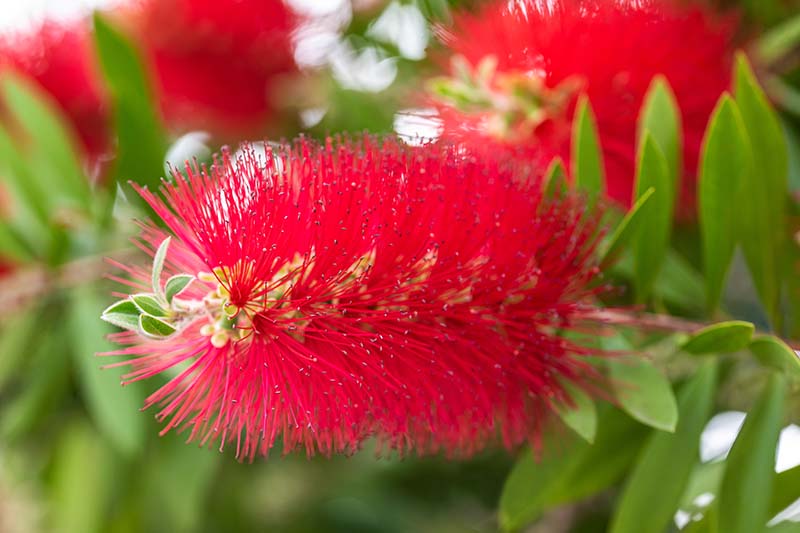
This is not to be confused with Sanguisorba obtusa, another species that is sometimes called the bottlebrush plant, or the bottlebrush buckeye, Aesculus parviflora.
Endemic to Australia, bottlebrush shrubs are widely cultivated around the world. C. citrinus was first introduced in Europe in the late 1700s by the botanist Joseph Banks, and they soon became popular garden plants.
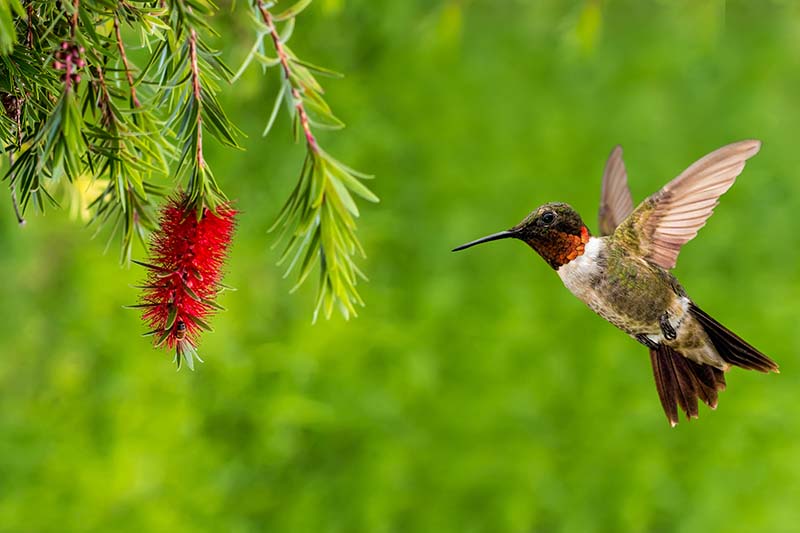
These shrubs can be grown outdoors year-round in USDA Hardiness Zones 8b to 11b. In colder zones, they should be brought indoors for the winter.
Species in this genus are known for their vibrant spikes of red, crimson, white, or yellow flowers that resemble a brush like you might use to clean a bottle.
Leaves are pointy, small, and narrow, ranging in color from silvery to blue-green or green.
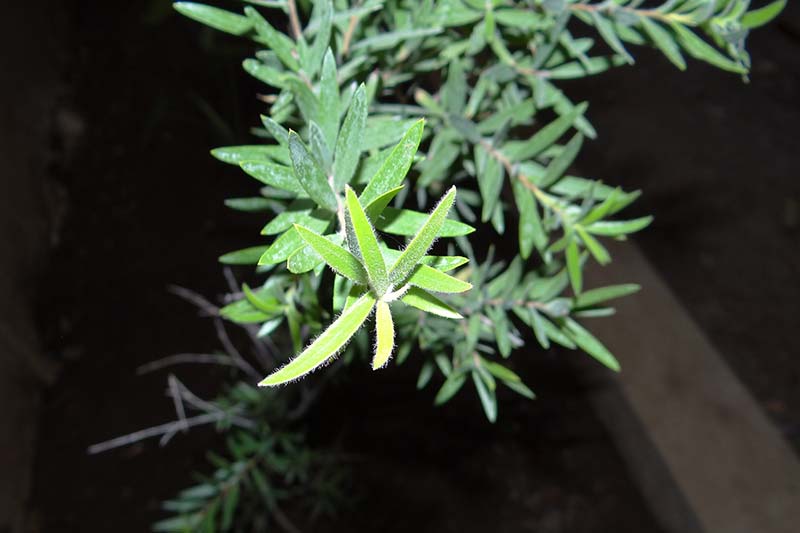
The flowering season is long with blooms continuing throughout the summer and attracting all sorts of pollinators, including hummingbirds, butterflies, bees, and wasps.
Shrubs tend to range between three and 15 feet in height. Some species can also be pruned and trained as trees up to 25 feet tall.
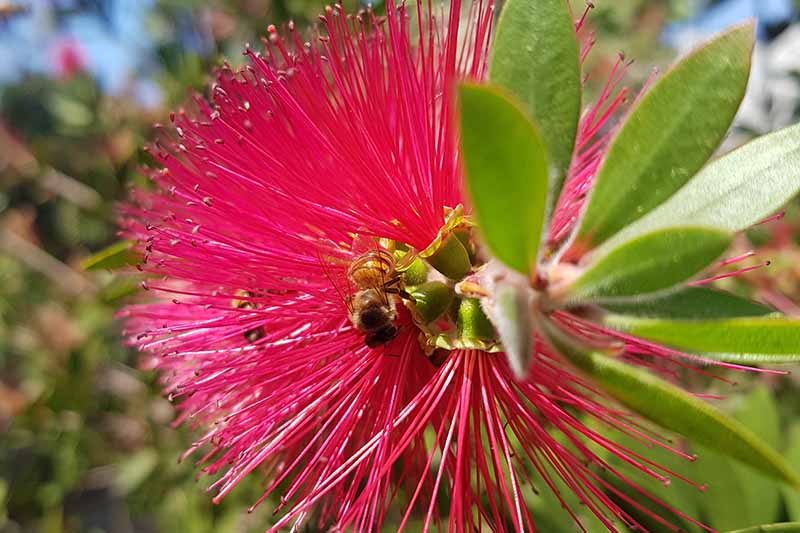
Bottlebrushes are closely related to paperbarks (Melaleuca spp.), which have similar flowers.
There is some debate as to whether Callistemon and Melaleuca should actually be considered separate genera, and botanists are currently studying these plants to determine the best classification.
In the early 2000s, most species previously categorized as Callistemon were merged with the Melaleuca genus, but this change is still controversial and not all botanists are in agreement.
Nonetheless, commercial nurseries and others tend to continue to label bottlebrushes as “callistemon.”
Bottlebrush Plant Propagation
If you are willing to put in some time, bottlebrush plants can be propagated from seed or by rooting stem cuttings.
From Seed
The small woody fruits stay attached to the plant for two to three years before releasing their seeds. Because of this, you can collect the fruits for seed propagation at any time of year.
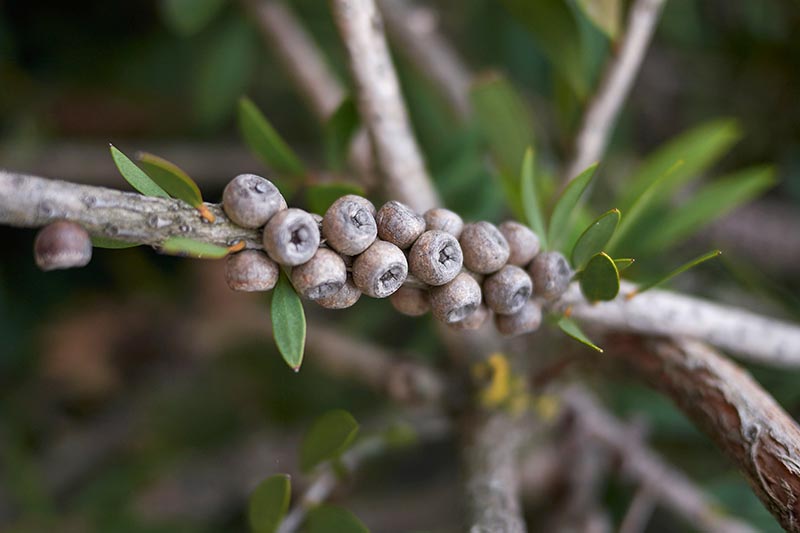
Just look lower down on the branches for older fruits that have not yet opened.
For best results, choose ones that are at least a year old.

Place the fruit in a paper bag and set it in a warm, dry location. In a few days, the fruit will crack open, exposing the tiny seeds inside.
The seeds are best used fresh. Surface sow each seed in moist, well draining potting soil in a four-inch pot.
Cover with a plastic dome to retain moisture and place the container in a warm spot that receives bright, indirect light.
A temperature of 80°F is ideal and a heat mat works well for helping to maintain consistently warm temperatures.
Keep the potting soil moist until germination. You should see sprouts in about two weeks.
Once seedlings emerge, remove the plastic dome but continue to keep the soil moist in a location that is well lit.
When the seedlings reach three inches in height, they can be repotted into two-gallon pots.
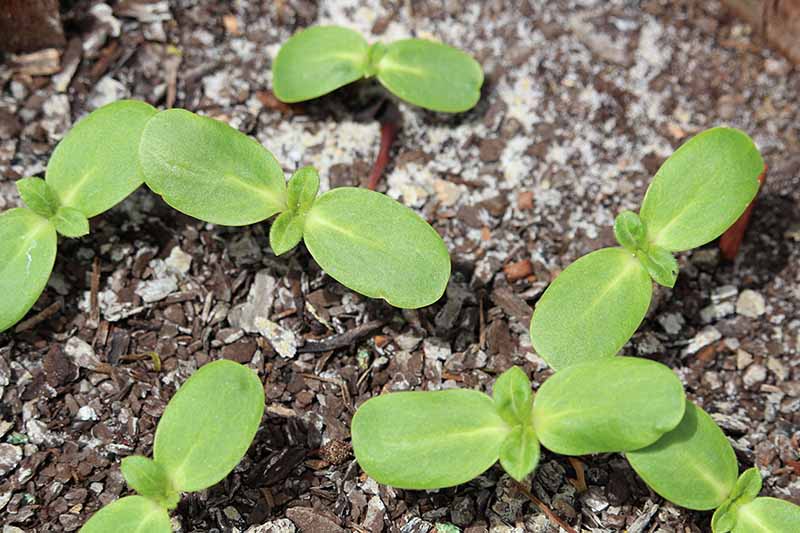
Keep these indoors in a warm, bright location for about six to nine months.
If you live in an area that gets light frosts in the winter, wait until after the risk of frost has passed in the spring to transplant outdoors.
From Cuttings
Similar to starting from seed, the process of growing a bottlebrush from cuttings takes a little time.
In the summer, cut a six-inch stem with three or more pairs of leaves from a healthy plant. Remove all of the leaves except the pair at the tip, as well as any buds.
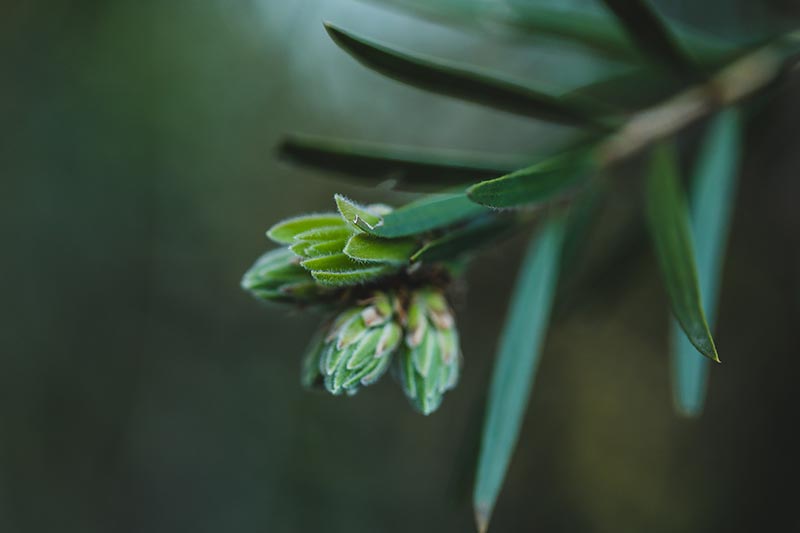
Choose a container that is at least six to eight inches in diameter and five inches deep. Fill it with a soilless mixture of half peat moss and half perlite.
Dip the cut end in powdered rooting hormone and plant it three inches deep in the pot. Multiple cuttings can be planted three inches apart in the same pot, if you wish.
Water until the planting medium is moist and tent with a clear plastic bag to retain moisture. Set the container in a warm place that receives at least six to eight hours of filtered light per day.
Check daily, and remove the plastic for a few minutes each day to allow for air circulation.
In four to six weeks, try tugging gently on the stem to check for the formation of roots. If the stem resists, that means roots have formed and your cutting is ready to repot in potting soil.
Repot rooted cuttings in individual containers in a peat-based potting soil mix and keep in a warm, sunny window.
These plants can grow in temperatures up to 90°F without problems, just be sure conditions always stay above 50°F.
Continue to grow the cuttings indoors until the following spring, when they can be planted outside. Be sure to wait until all risk of frost has passed to plant outdoors.
From Seedlings or Transplanting
It is always a good idea to harden off seedlings prior to planting outdoors. This process will help to reduce transplant shock, and plants will more readily adapt to outdoor conditions.
A week or two prior to planting, set seedlings outside in a protected location for about an hour.
Continue to do so each day as planting time approaches, slowly increasing the length of time spent outdoors and the amount of exposure to direct sunlight they receive.
Bottlebrush shrubs are widely available as nursery stock, and they can be planted in a similar fashion to established starts propagated at home.
After all threat of frost has passed, dig a hole that is just larger than the root ball. Set the plant in the hole and backfill with a mixture of garden soil and compost.
Surround the base of the plant with a few inches of mulch, such as shredded bark or pine needles, and water well. Keep the mulch an inch or two away from the stem.
Space three feet apart if planting multiple shrubs in one area.
How to Grow Bottlebrush Shrubs
These shrubs grow best in full sun. They will tolerate part shade, but won’t produce as many flowers. Aim for a location that receives at least six to eight hours of sun a day.

Loamy soil is best, though they aren’t picky about soil type. Just be sure to add some compost to the soil when you’re planting.
It is also important to choose a location with well draining soil. Mixing compost into the soil and mulching can help to improve drainage.
Young shrubs should be watered each week by slowly and deeply saturating the soil.
Once established, most species are drought tolerant. Water only in periods of prolonged drought when the soil is extremely dry. Avoid standing water, which can encourage rot.
Chemical fertilizer is not necessary, and an overabundance of nitrogen can lead to poor flowering.
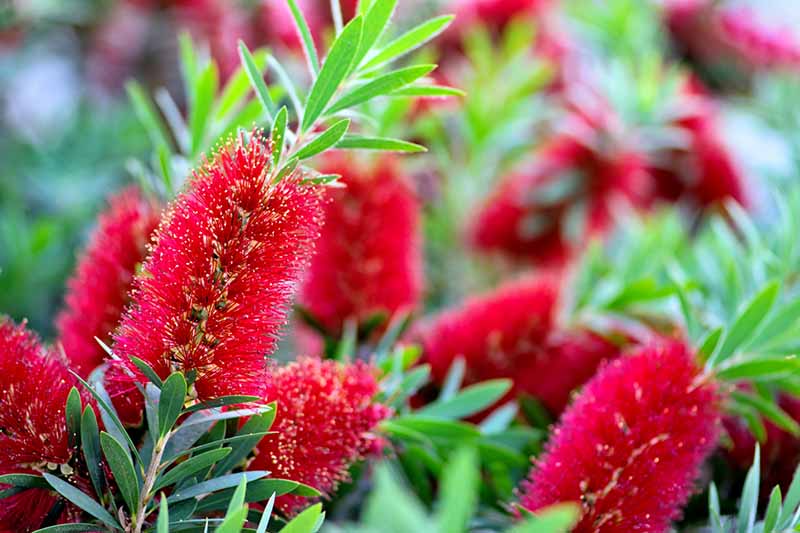
Instead, pull back the mulch each spring and add a two-inch layer of fresh compost over the soil to the drip line.
These desert shrubs can survive very high temperatures, but conversely, they can not tolerate frost.
If freezing temperatures are predicted, wrap shrubs in a sheet or muslin cloth to protect them, but leave an opening at the top for ventilation to prevent powdery mildew and leaf spot.
Don’t worry if leaves experience some browning; they should recover as long as the branches survive.
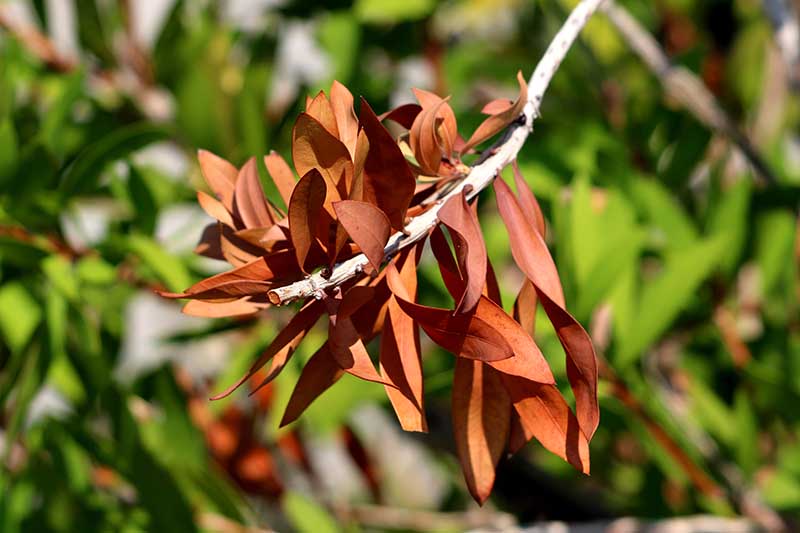
While you may be able to protect them temporarily from cold snaps, these heat-loving plants won’t survive temperatures below freezing for long.
For growers in colder climates, plan to grow these shrubs in containers from the start, or pot up and move shrubs indoors for the winter.
Choose a large pot of at least 16 inches in diameter with good drainage. Fill with a peat-based potting soil mix. Adding a bit of sand to the mixture can help improve drainage.
Keep the pot in a bright indoor space, checking regularly and watering occasionally when the soil is dry. There is no need to fertilize over the winter.
Keep potted plants inside until after the last frost, at which point you can harden them off for a week or two, and then return them to a sunny spot outdoors.
Growing Tips
- Choose a location that receives at least six to eight hours of sun per day.
- Amend soil with compost prior to planting.
- Water deeply once a week until well established and then only during prolonged dry spells.
- Protect from cold snaps with a sheet or muslin cloth, and keep indoors during winter in Zones 8a or below.
Pruning and Maintenance
Bottlebrush can be grown as a shrub or pruned to have a single trunk and resemble a tree.
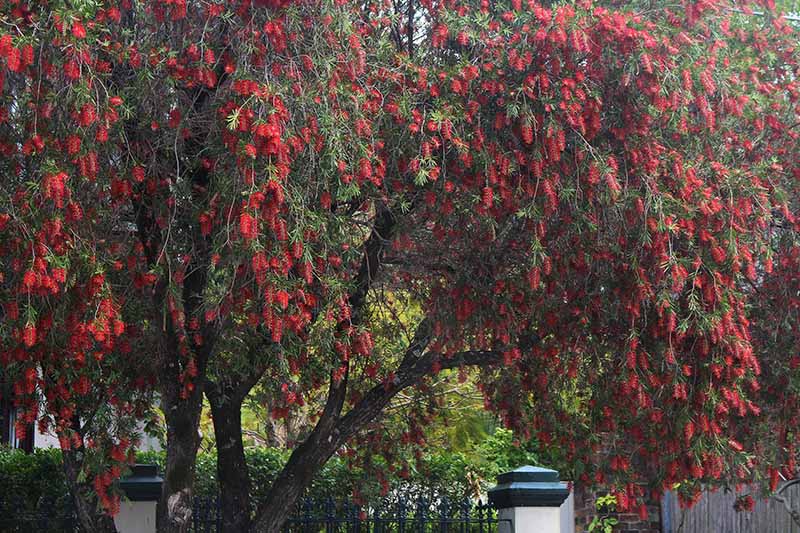
In late winter, you can cut the lower branches that are hanging down until you achieve the shape you desire. Trim stems individually, cutting just above a node on each branch.
Remove any suckers that sprout from the roots by cutting them back to the ground.
Pruning for general maintenance should be done in early spring or later summer.
Remove any dead or damaged branches and any branches that show signs of disease, and lightly thin interior branches to improve exposure to sunlight and airflow.
Bottlebrushes grown in pots can be pruned back heavily each year, to keep shrubs to a more manageable size.
Bottlebrush Species and Cultivars to Select
There are a variety of species available, with flowers in a range of colors and sizes ranging from dwarf shrubs to trees. Several of these are popular in cultivation.
Crimson
A showy shrub, crimson or scarlet bottlebrush (C. citrinus) features vibrant red flowers with contrasting tips.
These light up spectacularly when bathed in the glow of the setting sun, and the foliage emits a lemony aroma when brushed against on hot days. Mature shrubs grow 10 to 15 feet tall.
Plants in #1 containers can be purchased from Nature Hills Nursery.
Weeping
The weeping bottlebrush (C. viminalis) is much larger, reaching 15 to 20 feet tall with drooping branches, blue-green foliage, and dense spikes of deep red flowers that grow up to six inches in length.
It blooms from spring through early summer and intermittently into the fall.
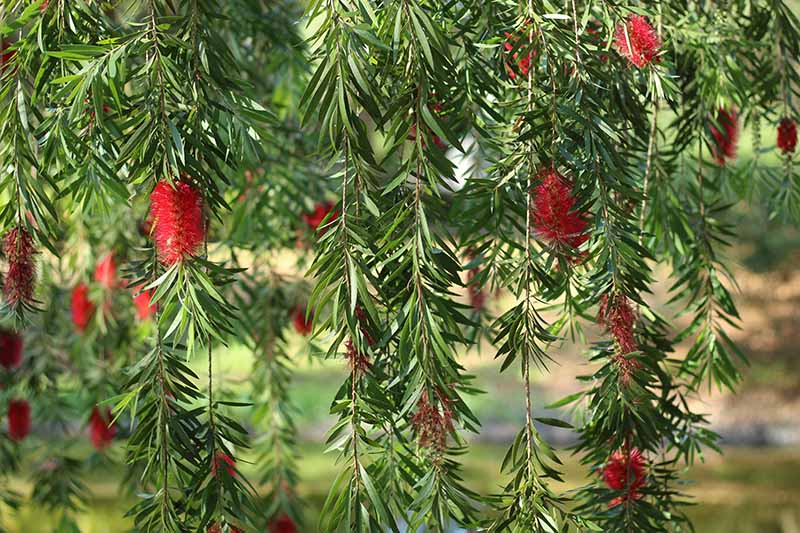
C. viminalis ‘Little John’ is a slow-growing compact dwarf shrub that tops out at three feet tall and wide.
It is covered with blood-red flower spikes that bloom over a long season, and dense branches with blue-green leaves that give off a citrus scent when crushed.
It is a great choice for container planting.
Plants are available in three-gallon pots from Home Depot and Fast Growing Trees.
Willow
Also known as the willow or white bottlebrush, C. salignus features dense willow-like foliage that is pink or red when it first emerges, and creamy white or yellow flowers.
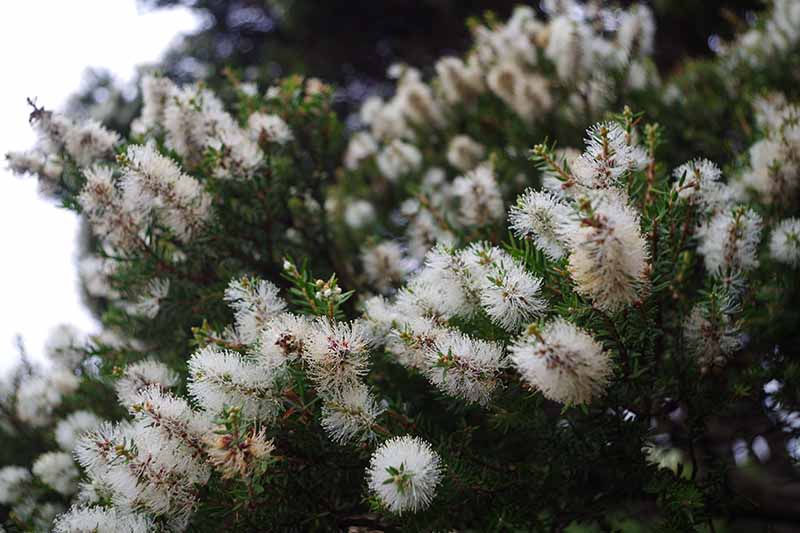
This evergreen shrub or small tree can grow up to 25 feet tall.
Managing Pests and Disease
While this is a low maintenance plant, there are still a few pests and diseases to keep an eye out for.
Insects
Watch for pests that can cause damage to foliage, and if not addressed, can sometimes serve as vectors for disease spread.
Root-Knot Nematodes
A microscopic roundworm that feeds on roots, this parasitic nematode sometimes invades bottlebrush trees, leading to a slow decline in their health.
Look for swollen roots along with wilting and yellowing leaves. Plants will appear dry even when the soil is adequately moist.
While there isn’t a lot you can do to completely eradicate root-knot nematodes once they appear, thick mulch can help to suppress populations.
Add a few inches of shredded bark or pine needles around plants, leaving a couple of inches bare around the stem.
Providing good growing conditions along with proper watering and pruning will help to reduce the risk of issues with this pest.
Sawflies
Adult sawflies lay eggs on the leaves and then the emerging larvae – little caterpillars with pointed tails – congregate to feast. They can quickly decimate the foliage of an entire shrub.

The larvae can be removed by hand, and large infestations can often be stopped with an application of neem oil.
Scale
Scale insects gather in groups to feed on sap contained within twigs and leaves. They produce honeydew, a sticky substance that can attract ants and lead to sooty mold.
Apply a horticultural oil such as neem oil or an insecticidal soap to the foliage and bark to kill scale.
You can find more information on scale insects here.
Disease
There are several diseases to be aware of with bottlebrush shrubs. Most problems tend to occur when soil becomes waterlogged or foliage is too wet.
Powdery Mildew
Appearing as a white coating on foliage, powdery mildew is another condition brought on by excessive moisture.
Water only when necessary and avoid overhead watering.
There are several easy organic methods for controlling powdery mildew, such as applying milk or baking soda to the leaves.
You can learn more about natural methods for addressing powdery mildew here.
Root Rot
When shrubs are overwatered and soil becomes soggy, a number of different types of fungi can infect the root system.
Photosynthesis is inhibited as roots rot, causing foliage to yellow and eventually leading to plant death.
You can avoid root rot by planting in well-draining soil – and remember not to overwater! Potted shrubs may need to be moved to new containers with better drainage holes.
Sooty Mold
This fungal disease appears as dark spots on the bark and leaves.
It is often a byproduct of a scale infestation, as the fungi that causes it (Capnodium spp.) consumes the honeydew secreted by these insects, and you may notice a colony of ants milling around the infected site.
Sooty mold has the potential to block sunlight, inhibiting photosynthesis.
It can be prevented by addressing scale infestations. Read more about dealing with sooty mold in the garden here.
Twig Gall
Twig Gall is a fungal disease, caused by Sphaeropsis tumefaciens.
Also prevalent in waterlogged soil, the fungi cause excessive numbers of shoots to spring from the bark and branches appear to bloat.
Remove and dispose of impacted branches and avoid excessive watering.
Move infected potted shrubs to containers with better drainage holes or add sand to improve drainage.
Verticillium Wilt
This soilborne fungal disease causes foliage discoloration, wilting, and dieback of leaves and branches. Unfortunately, it is nearly impossible to rid from the soil once it’s there.
Promptly remove and destroy affected branches and foliage, and consider moving the shrub to a new location.
Best Uses for Bottlebrush Bushes
These eye-catching shrubs have many uses in the landscape, all the while attracting hummingbirds and other pollinators to the garden when they are in bloom!
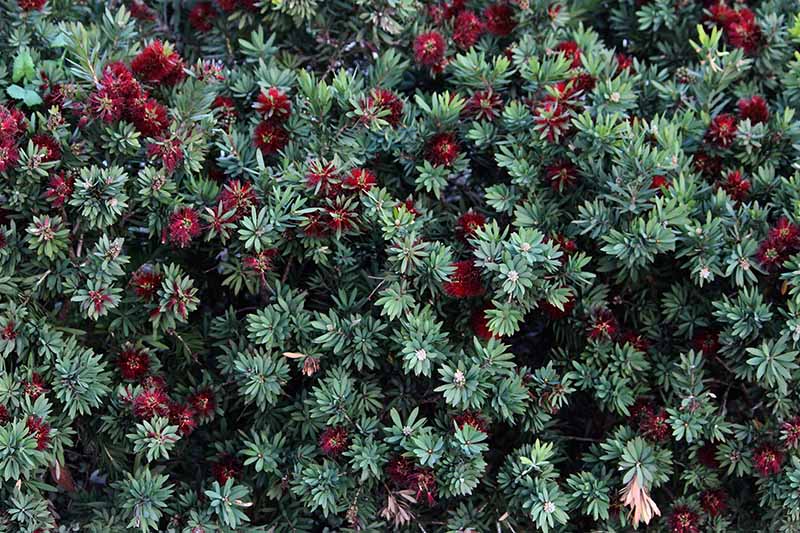
Their dense foliage makes them ideal shrubs for hedges, with the added bonus of dazzling color.
Line a drive or walkway, or place them as foundation plants under a window.
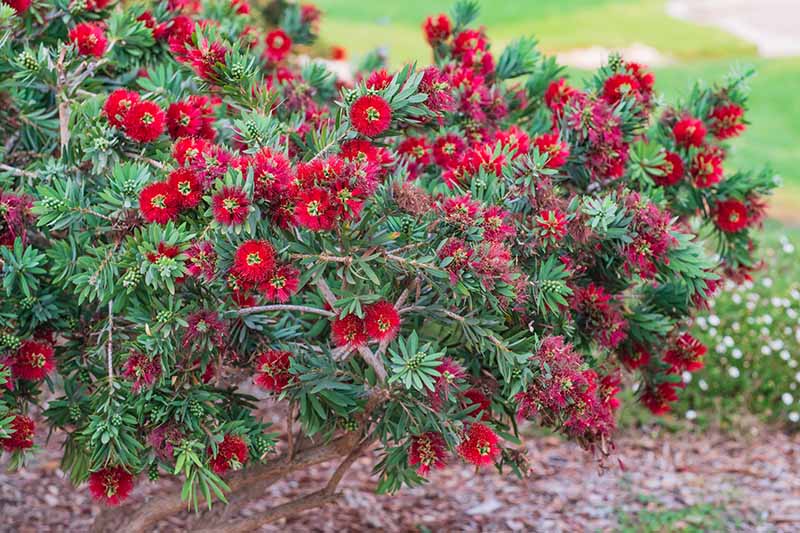
Or place container plants as a focal point on a deck or patio.
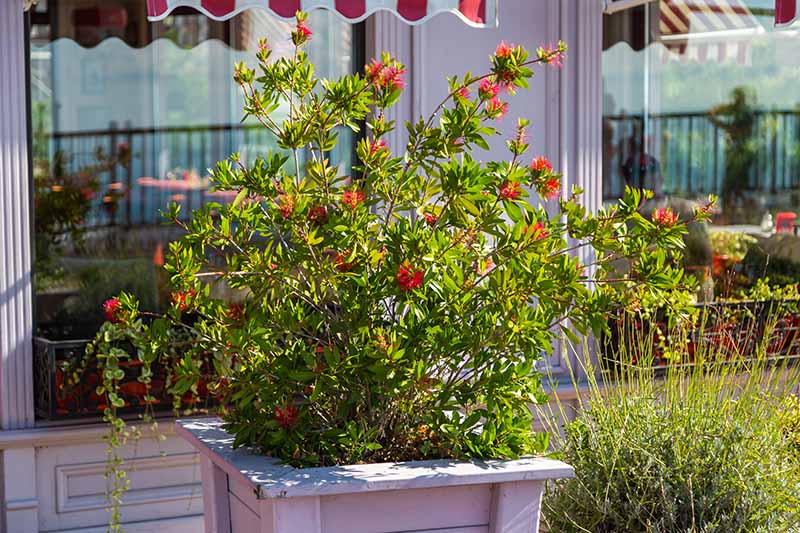
Bottlebrushes also make lovely cut flowers.
The foliage gives off a lemony scent when rubbed, so if you are using some in a floral arrangement, you can pinch the leaves to add a pleasant aroma to the space.
Quick Reference Growing Guide
| Plant Type: | Evergreen flowering ornamental shrub | Flower / Foliage Color: | Red, white, yellow/blue-green, green, silver |
| Native to: | Australia | Maintenance: | Low |
| Hardiness (USDA Zone): | 8-11 | Tolerance: | Heat, drought |
| Bloom Time / Season: | Spring and summer | Soil Type: | Loam |
| Exposure: | Full sun | Soil pH: | 5.6-7.5 |
| Spacing: | 3 feet | Soil Drainage: | Well-draining |
| Planting Depth: | Depth of root ball, surface sow seeds | Attracts: | Hummingbirds, butterflies, bees, wasps |
| Time to Maturity: | 2 years | Uses: | Borders, foundation plants, focal points, cut flowers |
| Height: | Up to 25 feet | Family: | Myrtaceae |
| Spread: | Up to 15 feet | Genus: | Callistemon |
| Water Needs: | Low | Species: | citrinus, salignus, viminalis |
| Common Pests: | Root-knot nematodes, sawflies, scale | Common Diseases: | Powdery mildew, root rot, sooty mold, twig gall, verticillium wilt |
Dazzle ’Em
With elegant drooping branches, fuzzy flowers that bloom all summer long, and attractive evergreen foliage, bottlebrush is an excellent choice to brighten up the landscape.
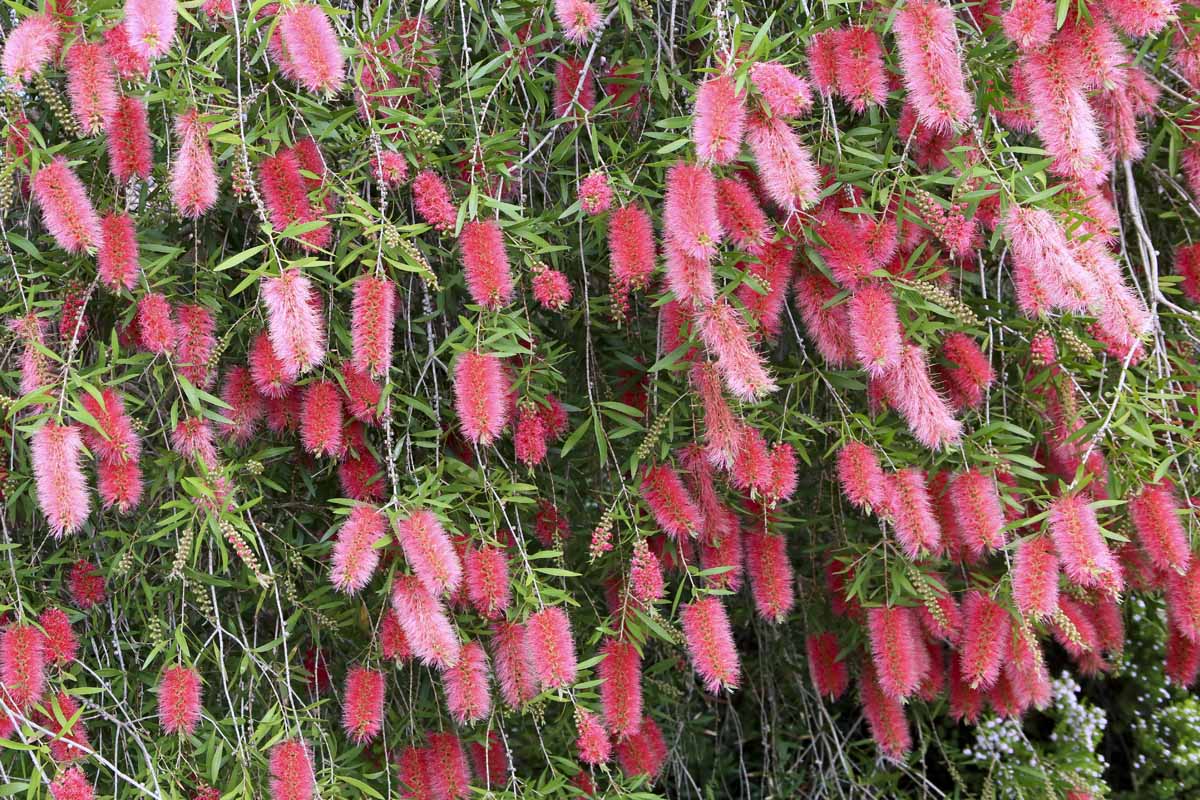
With very little effort, you can turn your garden into a space that’s the talk of the neighborhood.
Have you grown bottlebrush in your garden? Share your tips in the comments section below, and feel free to share a picture!
And for more information about growing shrubs in your landscape, check out these articles next:
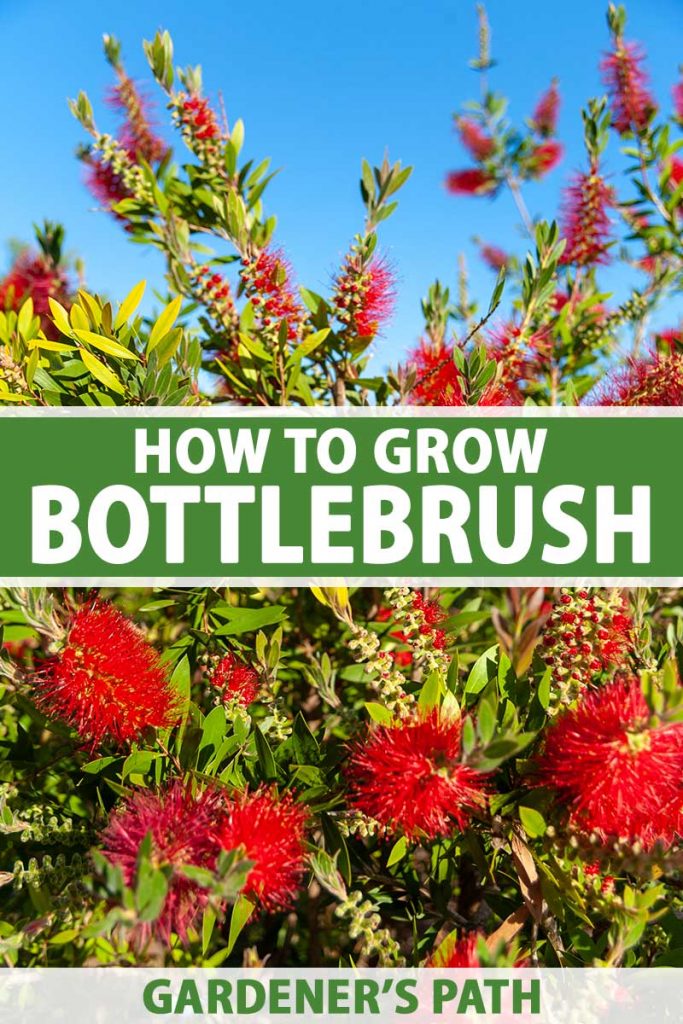
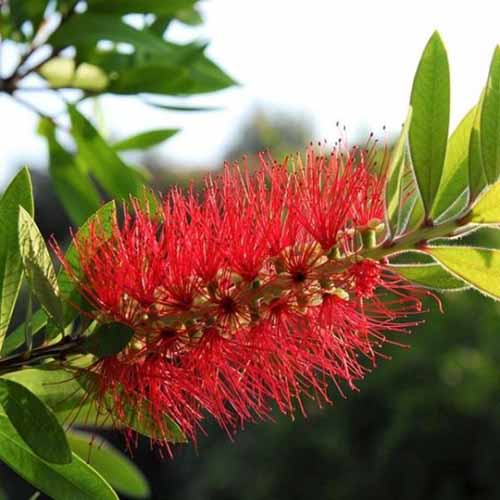
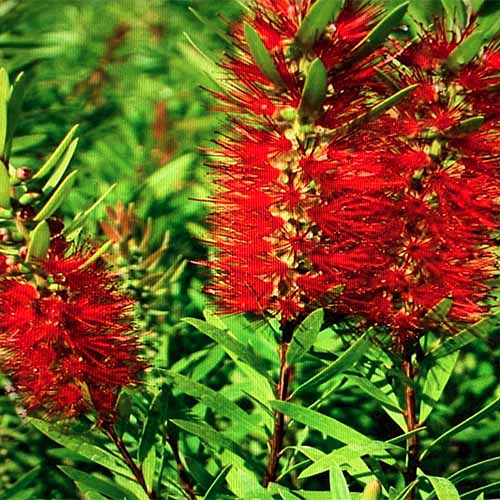
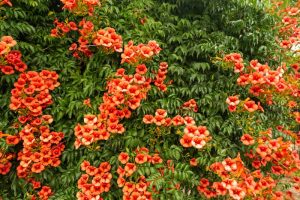
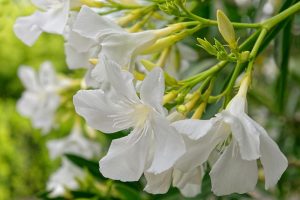
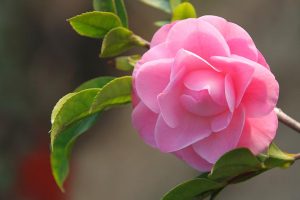
I bought two supposedly dwarf bottle brush about 3 years ago at a Lowes store in Las Vegas. I knew they were miss-marked when I got them because they were already over 3 Ft tall, but they were on sale so I grabbed them. they are now about 15 Ft tall and 3 Ft wide, but I have no idea what type they are really supposed to be. Any idea? After reading this article I am thinking crimson.
It’s difficult to tell from this distance, but that sounds likely!